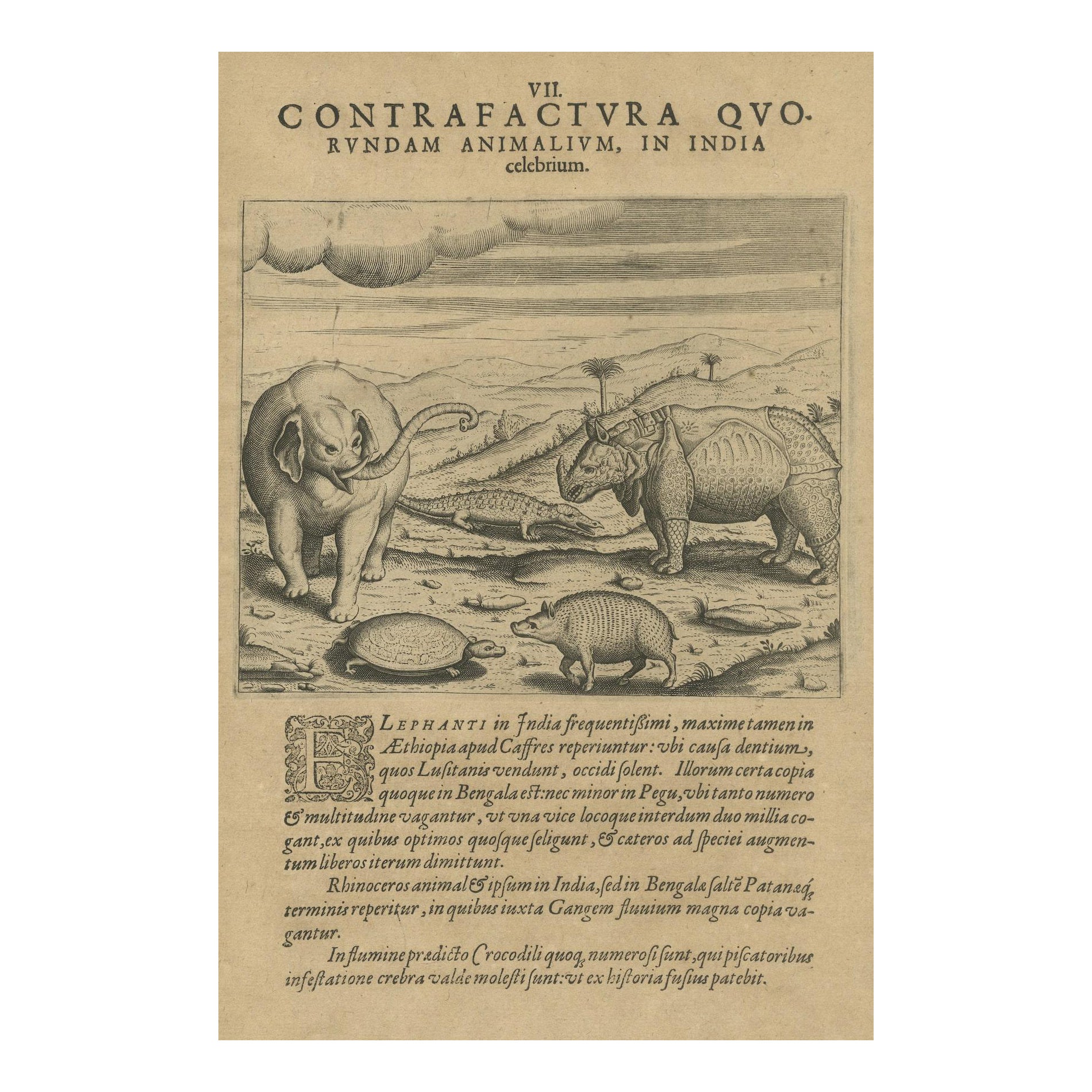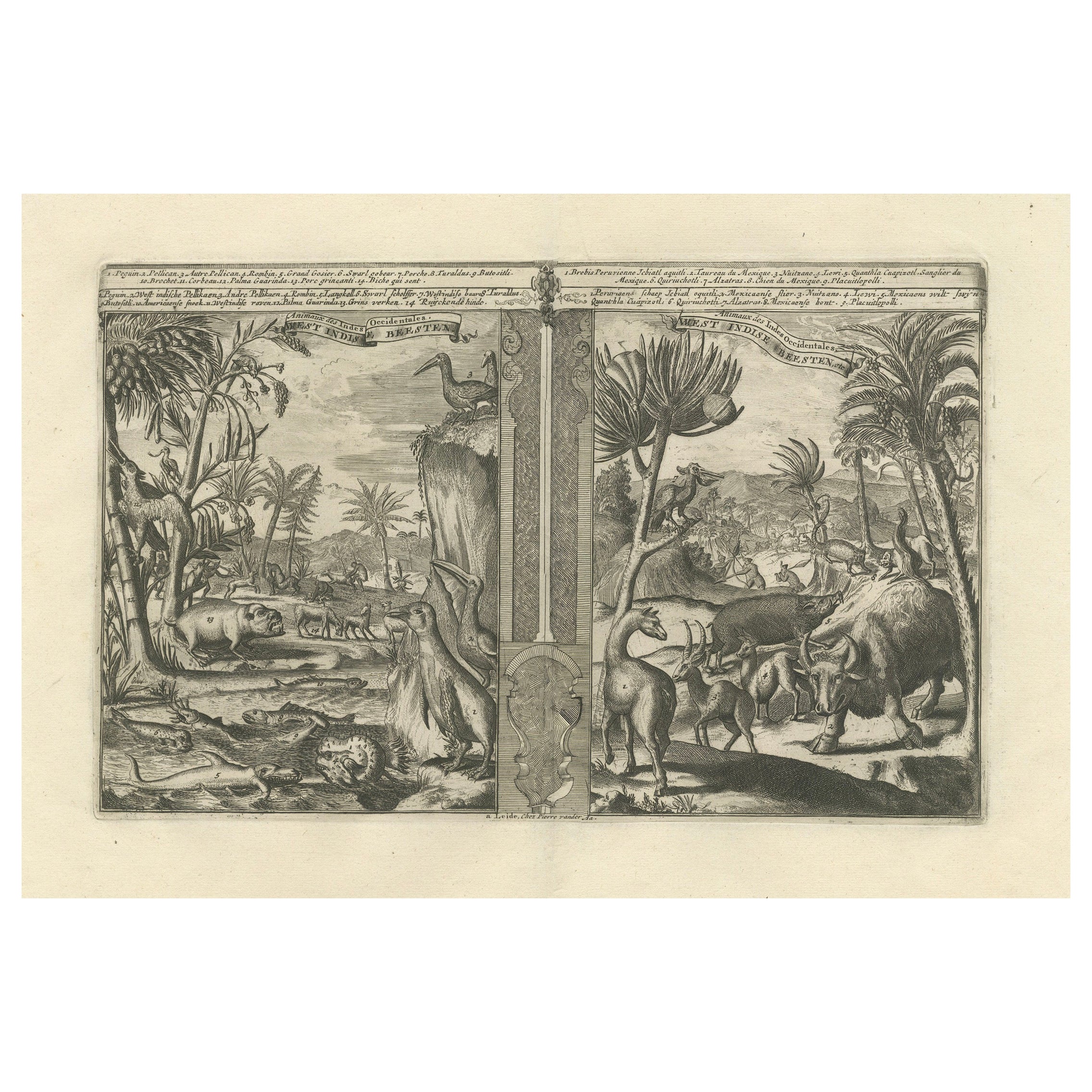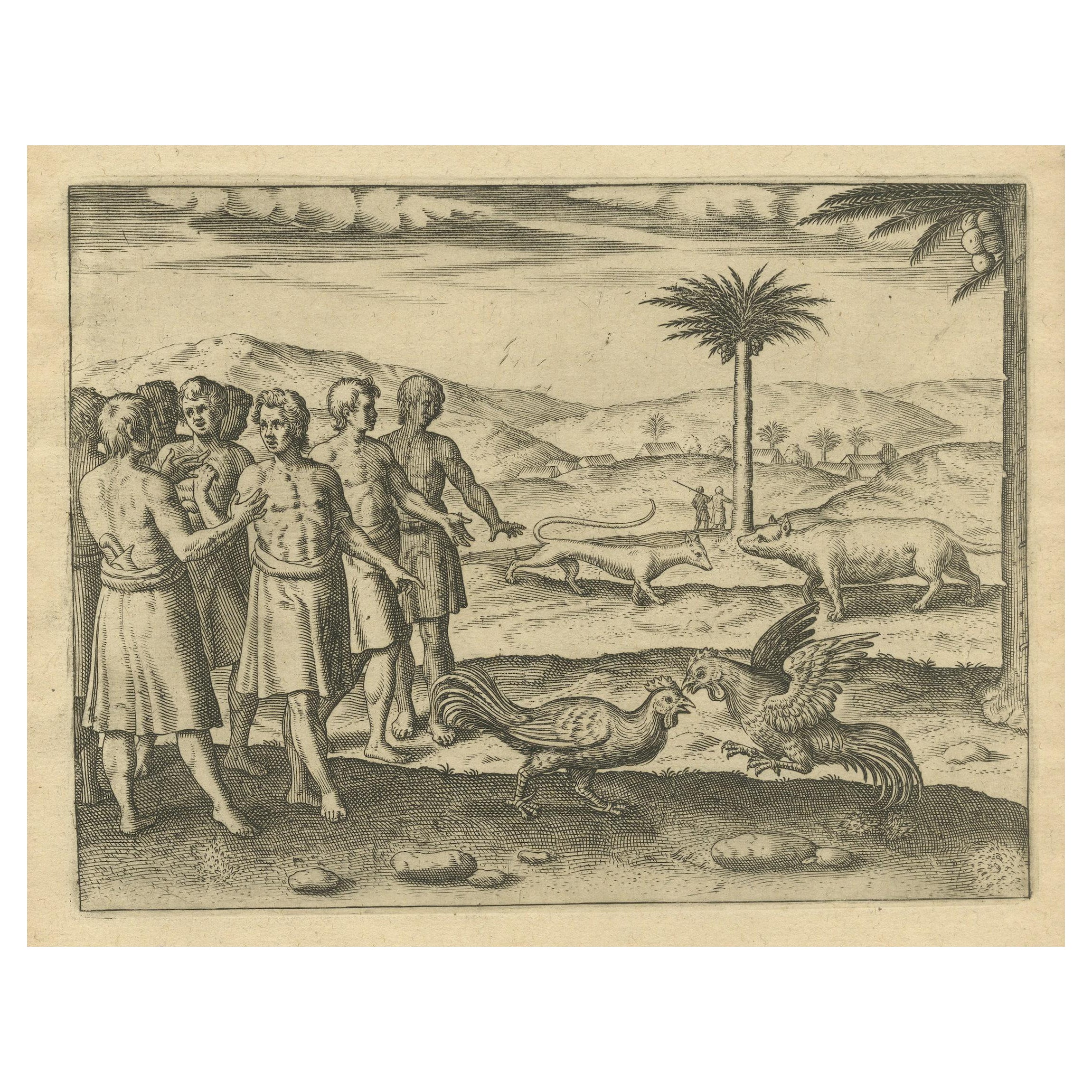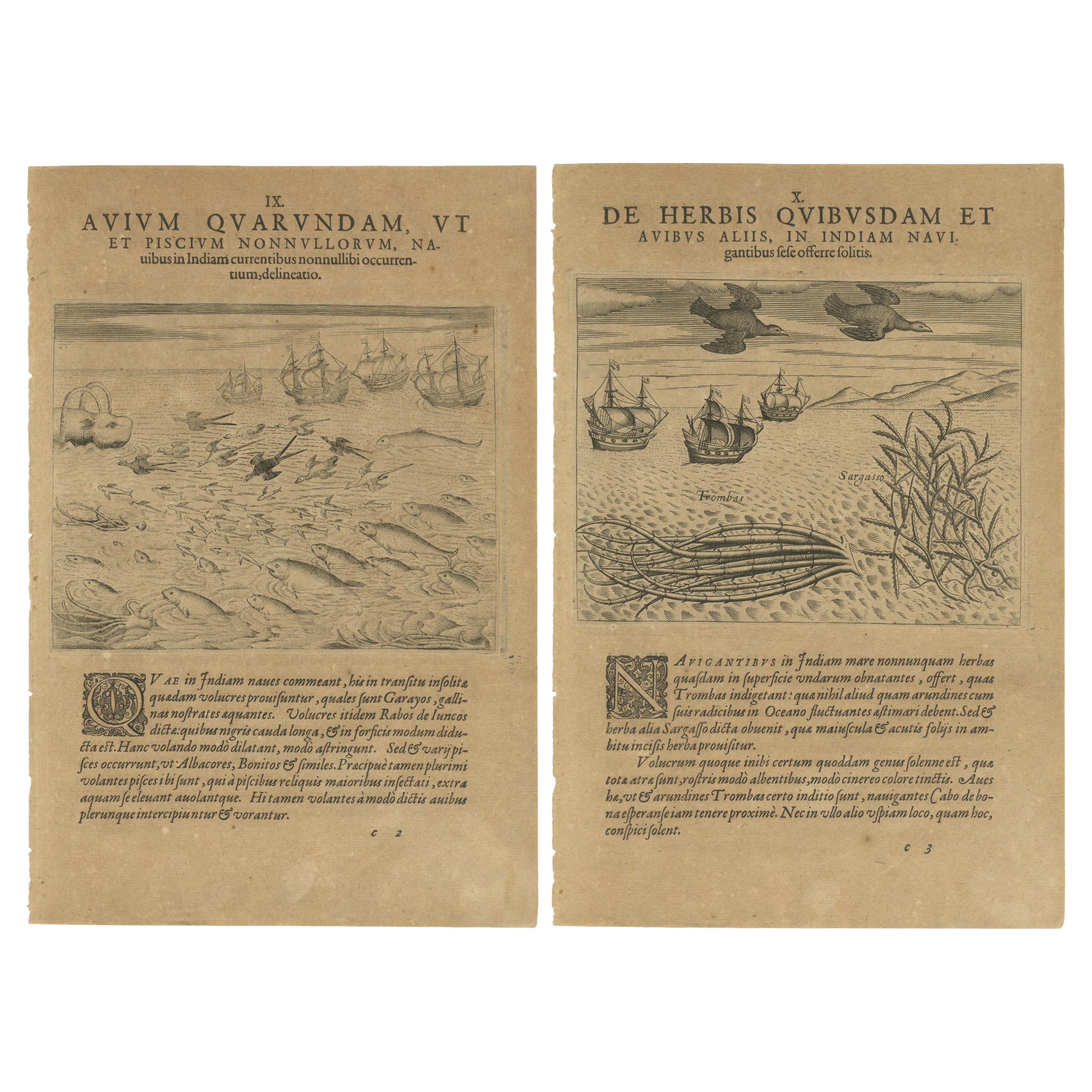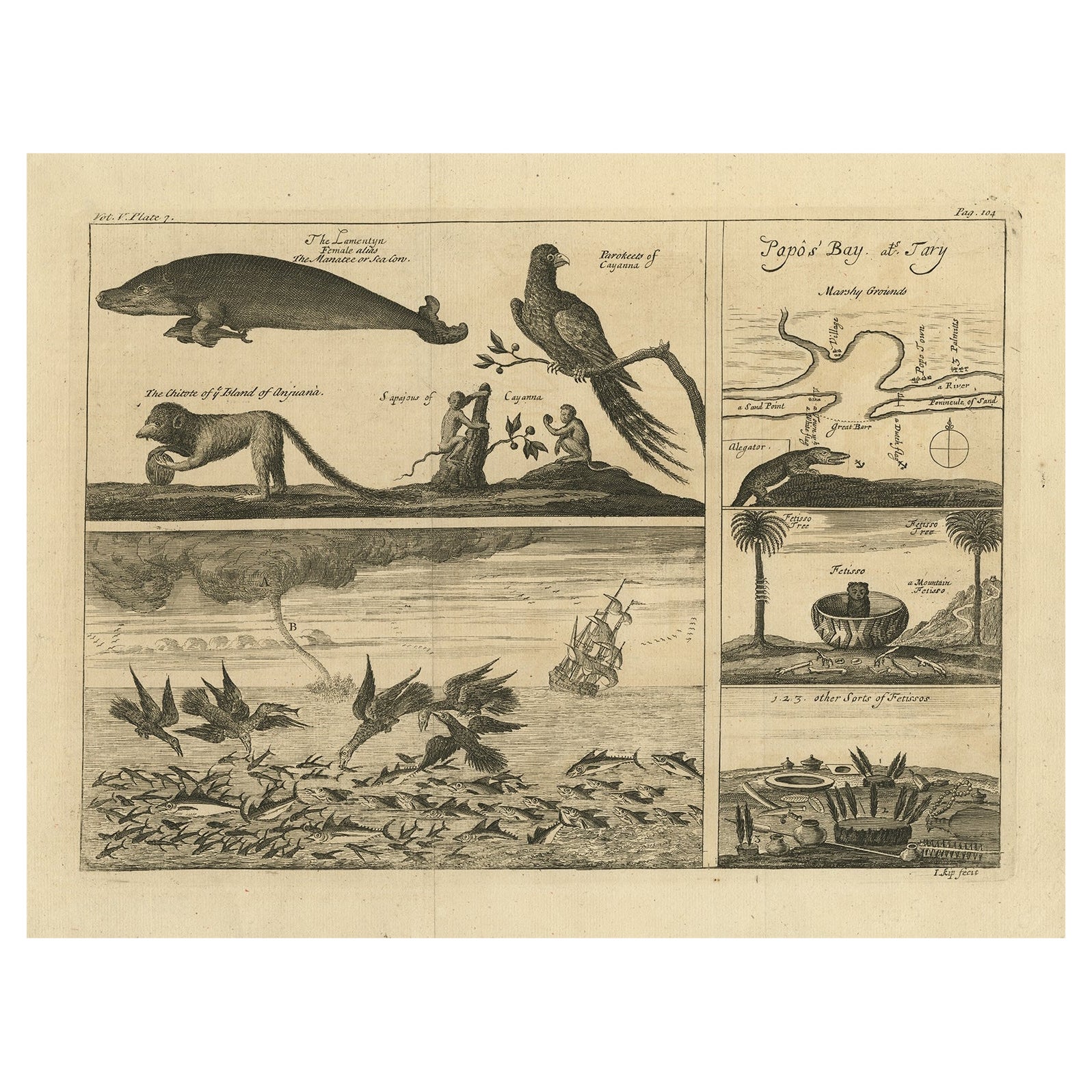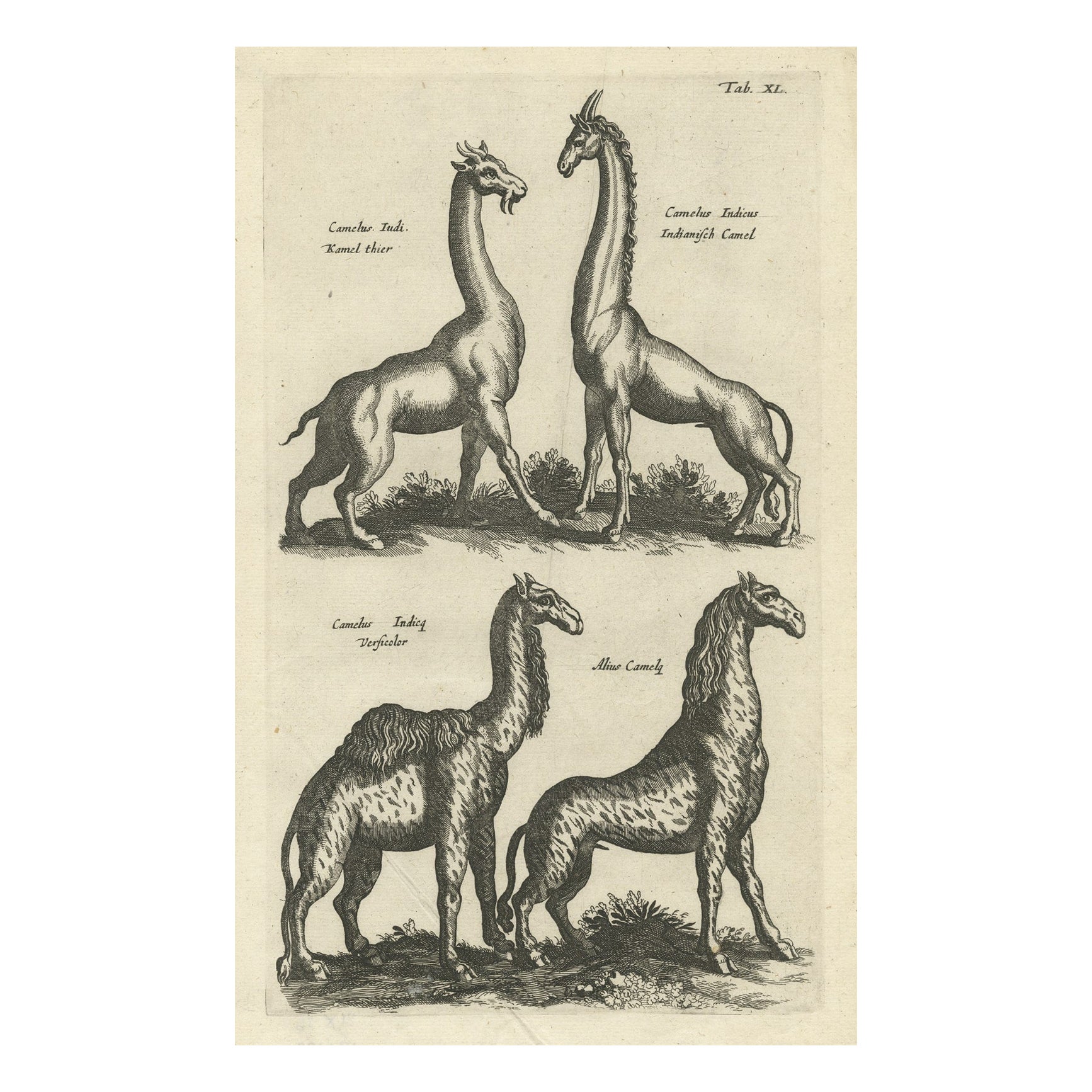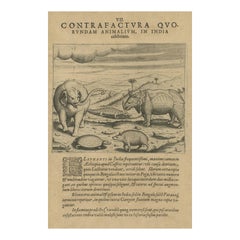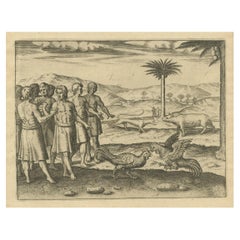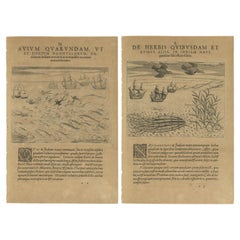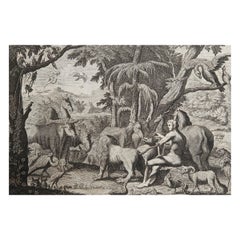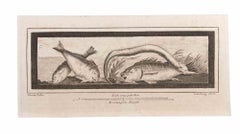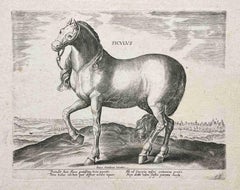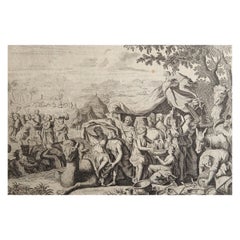Items Similar to Rare Creatures of the East: A 1601 de Bry Copper Engraving from the Indies
Want more images or videos?
Request additional images or videos from the seller
1 of 9
Rare Creatures of the East: A 1601 de Bry Copper Engraving from the Indies
$526.07
$657.5920% Off
£389.45
£486.8120% Off
€440
€55020% Off
CA$727.95
CA$909.9420% Off
A$802.55
A$1,003.1920% Off
CHF 419.87
CHF 524.8320% Off
MX$9,845.78
MX$12,307.2320% Off
NOK 5,285.30
NOK 6,606.6320% Off
SEK 4,942.59
SEK 6,178.2420% Off
DKK 3,351.65
DKK 4,189.5620% Off
About the Item
Title: "Rare Creatures of the East: A 1601 de Bry Engraving from the Indies"
Description: This original 1601 engraving from Theodore de Bry's collection presents a fascinating array of exotic animals found in the East Indies, as perceived by European explorers of the time. The scene is rich with life, featuring a variety of creatures that captivated the imagination of the old world. Central to the engraving is a bird that locals called "Eeme," possibly an emu or another large flightless bird, set against a backdrop of sailing ships that allude to the era of discovery.
In the foreground, a robust bovine creature grazes peacefully, while a lounging feline predator rests nearby, suggesting the diverse ecosystems encountered by travelers. A reptilian creature, likely a crocodile, basks in the foreground, and a salamander, which is noted for being frequently seen in Madagascar, is also depicted, hinting at the biodiverse richness of the region.
The text provided appears to be in Latin, from a work that likely describes the natural history or zoology of a particular region, possibly India. Here is the English translation:
"In India, especially on the island of Java, there are some birds that are rare and admirable, which the inhabitants call Eeme. These are of the size of a camel, lacking a tongue, and have small wings. The robustness of their body is in the legs, which are long and strong. Whatever they eat, they consume whole, whether it be apples or other fruits. This same thing happens during the day, when they return what they consumed, undigested.
Adjacent to these, there are also wild oxen; as well as Chameleons, and Salamanders, which are frequently found in Madagascar."
The engraving is meticulously detailed, offering a window into the European explorers' first encounters with the natural world of the East Indies. De Bry's work was instrumental in shaping the European understanding of foreign wildlife, and this piece is a testament to the allure and mystery that these distant lands held for the European audience of the 17th century. It is not only a remarkable piece of historical art but also an enduring record of the natural world as it was envisioned during the Age of Exploration.
As an original piece from the first edition of Part VII of "Indiae Orientalis," this work is a valuable collector's item, not only for its historical significance but also for its aesthetic beauty and the window it opens onto the perceptions and curiosities of a bygone era. It stands as a testament to the wonder and allure that the flora and fauna of India held for the European mind, and it would serve as a prestigious and conversation-evoking piece for any collection.
This plate is part of the "Petit Voyages" or "Small Voyages," a series that complemented the "Grands Voyages" or "Great Voyages." Theodore de Bry, a noted engraver and publisher from Liège, Belgium, began these works to illustrate the New World and the Far East based on accounts and drawings from explorers. His works grew to comprise 30 volumes, with later editions published by his children after his death. This particular engraving is a testament to the enduring allure of the unknown that captivated the minds of Europeans during the Age of Exploration.
This piece forms part of a larger corpus of works produced under the supervision of the de Bry family, a lineage of renowned engravers and publishers based in Frankfurt. Initiated by Theodore de Bry in 1590, this series aimed to visually document the epoch of European global exploration and the encounters with the natural world that ensued.
The engraving is a page from Part IV of de Bry's "Petits Voyages," which narrates significant expeditions to the East Indies, including those led by Jan Juygen van Linschoten and Cornelis de Houtman between 1595-97, as well as the journey by Jacob van Neck and Wybrandt van Warwijck in 1598-99. These works were not merely artistic endeavors but also ethnographic records, showcasing indigenous peoples, fauna, flora, and the diverse riches of lands like India, Madagascar, and the East Indies.
Though Theodore de Bry began this ambitious project, it was continued posthumously by his family and later completed by his son-in-law, Matthaus Merian, in 1644. This particular engraving, rich in detail and drama, offers a window into the perilous and wondrous experiences of early explorers, and the ways in which these moments were captured and communicated to a European audience hungry for knowledge of the wider world.
- Dimensions:Height: 11.82 in (30 cm)Width: 7.88 in (20 cm)Depth: 0 in (0.02 mm)
- Materials and Techniques:Paper,Engraved
- Period:Early 17th Century
- Date of Manufacture:1601
- Condition:The condition of the print is very good, considering its age of over 400 years. Light brownish toning and some soiling due to handling, mainly around the edges. Please study this image carefully.
- Seller Location:Langweer, NL
- Reference Number:Seller: BG-13596-91stDibs: LU3054337755192
About the Seller
5.0
Recognized Seller
These prestigious sellers are industry leaders and represent the highest echelon for item quality and design.
Platinum Seller
Premium sellers with a 4.7+ rating and 24-hour response times
Established in 2009
1stDibs seller since 2017
2,609 sales on 1stDibs
Typical response time: <1 hour
- ShippingRetrieving quote...Shipping from: Langweer, Netherlands
- Return Policy
Authenticity Guarantee
In the unlikely event there’s an issue with an item’s authenticity, contact us within 1 year for a full refund. DetailsMoney-Back Guarantee
If your item is not as described, is damaged in transit, or does not arrive, contact us within 7 days for a full refund. Details24-Hour Cancellation
You have a 24-hour grace period in which to reconsider your purchase, with no questions asked.Vetted Professional Sellers
Our world-class sellers must adhere to strict standards for service and quality, maintaining the integrity of our listings.Price-Match Guarantee
If you find that a seller listed the same item for a lower price elsewhere, we’ll match it.Trusted Global Delivery
Our best-in-class carrier network provides specialized shipping options worldwide, including custom delivery.More From This Seller
View AllOriginal Copper Engraving of Various Celebrated Animals in India by De Bry, 1601
Located in Langweer, NL
Title: "Exotic Bestiary: A 1601 de Bry Engraving of India’s Majestic Fauna"
This captivating 1601 copper engraving by Theodore de Bry from his "Indiae...
Category
Antique Early 17th Century Prints
Materials
Paper
$621 Sale Price
20% Off
Colonial Curiosities: Fauna of the West Indies, by R. de Hooghe, circa 1708
Located in Langweer, NL
This original antique print is an intricate engraving from the early 18th century, titled "India Occidentalis," also known as the West Indies. Created by Romeyn de Hooghe, a distingu...
Category
Antique Early 1700s Prints
Materials
Paper
$631 Sale Price
20% Off
The Cockfight of Java: A 1601 de Bry Engraving of Cultural Pastimes
Located in Langweer, NL
Original Antique engraving by Theodore De Bry from 'Pars Quarta Indiae Orientalis...,' 1601, with descriptive Latin text below the image.
This 1601 e...
Category
Antique Early 17th Century Prints
Materials
Paper
$526 Sale Price
20% Off
Maritime Life and Flora: Antique Engravings by De Bry, 1601
Located in Langweer, NL
Title: "Maritime Life and Flora: Antique Engravings by De Bry, 1601"
This pair of original antique engravings, published in 1601 by the famed engraver Theodore de Bry, showcases the...
Category
Antique Early 17th Century Prints
Materials
Paper
$277 Sale Price
20% Off
Antique Print with Various Creatures from A Travel Account, 1744
Located in Langweer, NL
Description: Antique print, titled: 'Papo's Bay (…).' - This plate shows five panels with various creatures (parakeet, sea cow, monkeys), a small map of Papo’s Bay at Tary (Cayenne?)...
Category
Antique 1740s Prints
Materials
Paper
$210 Sale Price
20% Off
Rare Antique Print of Various Animals, Camelus Iudi, Camelus Indicus Etc, 1657
Located in Langweer, NL
Antique print of various animals; Camelus Iudi, Camelus Indicus etc. This print originates from 'Historiae Naturalis (..)' by John Johnston, published by Matthias Merian in 1657.
...
Category
Antique 17th Century Prints
Materials
Paper
$325 Sale Price
20% Off
You May Also Like
Original Antique Print after Jan Luyken, Amsterdam, Genesis II, 1724
Located in St Annes, Lancashire
Wonderful copper-plate engraving after Jan Luyken
Published by Marten Schagen, Amsterdam. 1724
Text on verso
The measurement given is the paper size.
Category
Antique 1720s Dutch Renaissance Prints
Materials
Paper
Decoration With Animals - Etching by Carlo Oraty - 18th Century
Located in Roma, IT
Decoration With Animals is an Etching realized by Carlo Oraty (18th century).
The etching belongs to the print suite “Antiquities of Herculaneum Exposed” (original title: “Le Antich...
Category
Late 18th Century Old Masters Still-life Prints
Materials
Etching
Ca. 1578 Old Master Engraving "Siculus" After Jan vander Straet (Strandanus)
By Jan Van der Straet
Located in Chicago, IL
Ca. 1578, Engraving "Siculus" - from the portfolio “The Stables of Don John of Austria” (Equile Austriaci Caroli V)" After Jan van der Straet (Stradanus).
An Old Master print from the series of 43 engravings depicting horses of different breeds from the stables of John of Austria (1547-1578), son of Emperor Charles V. Each print shows a horse in the foreground on a hilltop overlooking a distant landscape. Each bears it's title breed, centered upper edge, with two columns of brief explanatory Latin texts in the lower margins. Published by Philips Galle...
Category
16th Century Old Masters Animal Prints
Materials
Engraving, Paper
Original Antique Print After Jan Luyken, Amsterdam, Genesis XXXI, 1724
Located in St Annes, Lancashire
Wonderful copper-plate engraving after Jan Luyken
Published by Marten Schagen, Amsterdam. 1724
Text on verso
The measurement given is the paper size.
Category
Antique 1720s Dutch Renaissance Prints
Materials
Paper
Original Antique Print after Jan Luyken, Amsterdam, Genesis II, 1724
Located in St Annes, Lancashire
Wonderful copper-plate engraving after Jan Luyken
Published by Marten Schagen, Amsterdam. 1724
Text on verso
The measurement given is the paper size.
Category
Antique 1720s Dutch Renaissance Prints
Materials
Paper
18th Century Color Engraving Print by Pieter F.H. Bruegel, La Peche
Located in Miami, FL
Original 18th century color engraving print by renowned artist Pe. F.H. Bruegel.
A fine crisp impression of great rarity; it is particularly unusual to find color engravings of this...
Category
Antique 18th Century French Prints
Materials
Paper
More Ways To Browse
17th Century Copper
Java Bird
Wiener Werkstatte Vase
Wood Carved Dog Head
Wood Slat Cabinet
Wood Snake Sculpture
Wooden Carved Trees
Wooden Rocking Horse
Wooden Wagon
Wrought Iron Balconies
Wrought Iron Balcony
Yellow Painted Chest
10 Drawer Dresser
17Th Century Casket
17th Century Italian Cassone
17th Century Chinese Incense Burner
18th Century Reproduction Furniture
18k Gold Snuff Box
